
According to the Energy Information Administration (EIA), U.S. petroleum inventories (excluding SPR) fell by 14.2 million barrels in the week ending December 15, 2017. They stand about 2 million barrels (mmb) higher than the rising, rolling 5-year average and are about 96 mmb lower than a year ago.
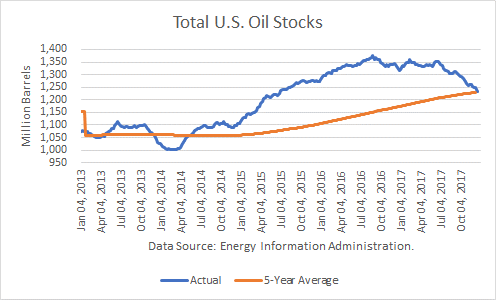
Commercial crude stocks fell by 6.5 mmb, and SPR stocks were built by 0.4 mmb last week. Gasoline stocks rose by 1.2 mmb, and distillate stocks gained 0.8 mmb. Primary demand rose by 640,000 b/d to average 19.948 million barrels per day (mmbd).
Crude Production
The EIA estimated (using its model, click here for presentation) that U.S. crude production rose by 9,000 barrels per day to 9.789 mmbd, the highest week in EIA’s database. Production averaged 9.740 mmbd over the past four weeks, up 11.4% v. a year ago. In the year-to-date, crude production averaged 9.313 mmbd, up 6.3% v. last year.
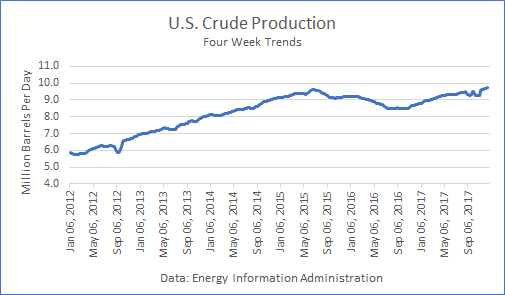
When the EIA announced a gain in U.S. crude production in September of 290,000 b/d over August, it surprised many market observers who believed shale oil production growth had been overstated in the weekly data. On December 15th, the state of North Dakota estimated that its production rose by 78,000 b/d in October, a gain of 7.0% from September. The new estimate, 1.185 million barrels per day, is just 36,000 b/d lower than the record set back in December 2014.
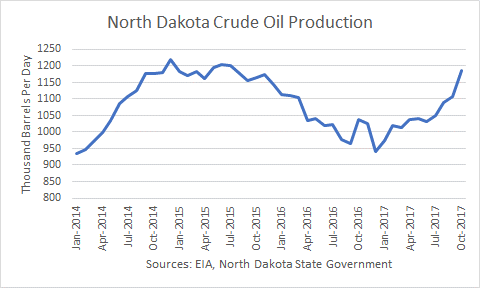
In his first days in office, President Trump had signed an Executive Order giving authority to accomplish the remaining steps to allow the Dakota Access Pipeline to be completed. It was finished in early June. The pipeline effectively reduced transportation costs by about $5/b on about 500,000 b/d. And so it has reduced the breakeven costs on that volume. Consequently, it follows that production should rise, and now there is tangible evidence that is the case.
Most recently, the DOE projected that shale oil production in the major producing basins will rise by 94,000 b/d in January to 6.41 million barrels per day (mmbd), setting a new record high.
The rise is nearly identical to the average monthly gain in 2017 and is comparable to gains estimated for November and December.
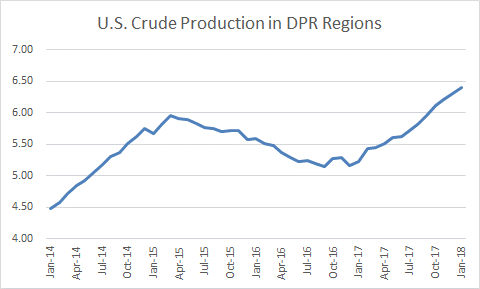
In addition, the DOE reported that the inventory of “Drilled But Uncompleted” wells (DUCs) reached a new record high in November of 7,354.
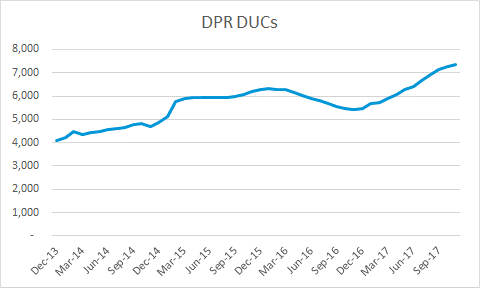
Well, completions totaled 1,086 in November, its highest level since April 2015.
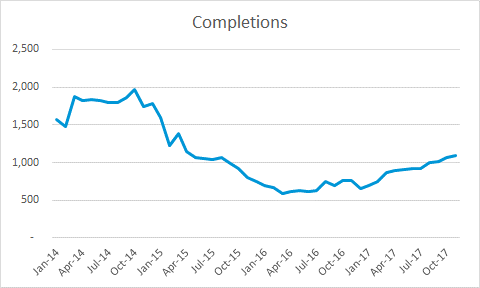
Other Supply
I have previously noted in an article how the “Other Supply,” primarily natural gas liquids and renewables, are integral to petroleum supply. The 4-week trend in “Other Supply” averaged 5.988 mmbd, up 7.5 % over the same weeks last year. In YTD, they are 4.3 % higher in 2017 v. 2016.
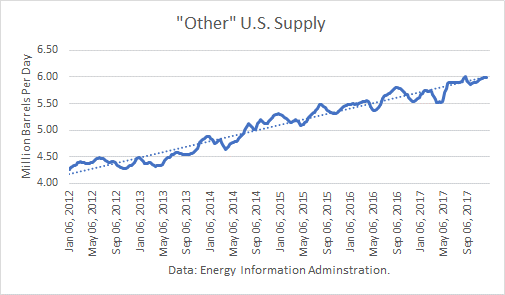
Crude production plus other supplies averaged 15.728 mmbd over the past four weeks, an all-time-high record.
Crude Imports
Total crude imports rose by 471,000 b/d last week to average 7.363 mmbd last week. This figure was below the 4-week trend of 7.432 mmbd, which was off 6.2 % from a year ago.
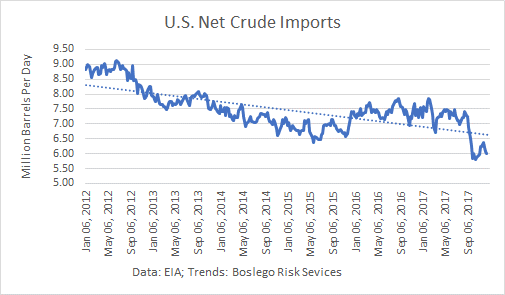
Net crude imports fell by 301,000 because exports rose by 772,000 b/d to average 1.858 mmbd. Over the past four weeks, crude exports averaged 1.429 mmbd, 184 % higher than a year ago.
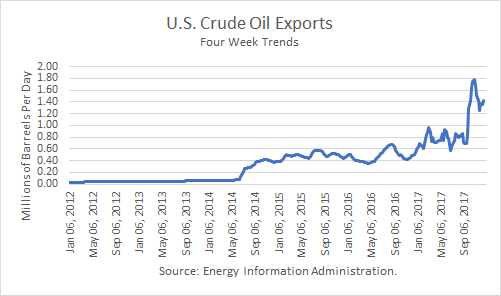
U.S. crude imports from Saudi Arabia fell by 66,000 b/d last week to average 512,000 b/d. Over the past four weeks, Saudi imports have averaged 639,000 b/d, off 31 % from a year ago.
Crude Inputs to Refineries
Demand for crude at refineries rose by 111,000 b/d last week to average 17.063 mmbd. Over the past four weeks, crude inputs averaged 17.053 mmbd, 3.6 % higher than a year ago. In the year-to-date, inputs averaged 16.532 mmbd, 1.9 % higher than in 2016.
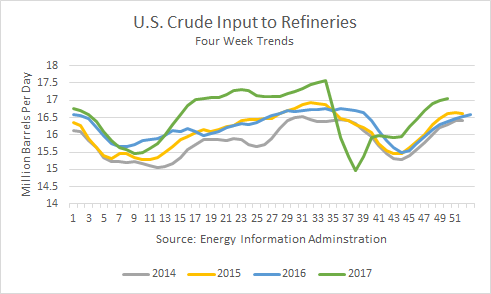
Crude Stocks
Over the past four weeks, crude oil demand exceeded supply by 877,000 b/d.
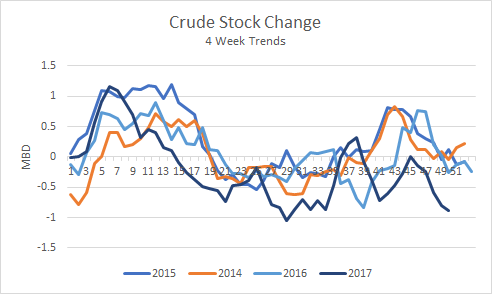
Commercial crude stocks are now 49.0 million barrels lower than a year ago.
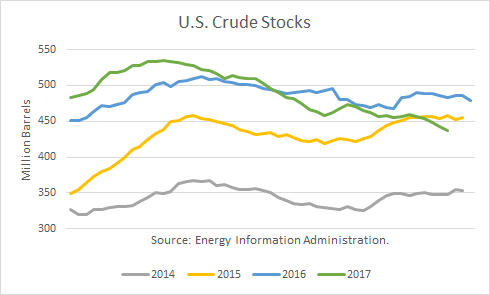
Petroleum Products
Given the recent net product stock draws, product demand has exceeded supply by 221,000 b/d.
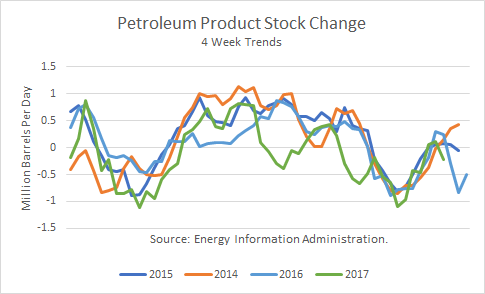
Total U.S. product stocks at 796 mmb are 47 million barrels lower than a year ago.
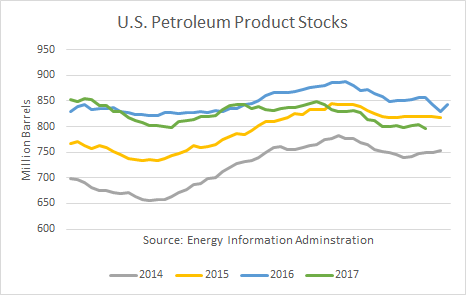
Product exports rose by 1.149 mmbd last week, averaging 5.695 mmbd. This figure is well above the 4-week trend of 5.3 mmbd, which is 8.7 % higher than a year ago. In the year-to-date, exports averaged 4.753 mmbd, 16.4 % higher than a year ago.
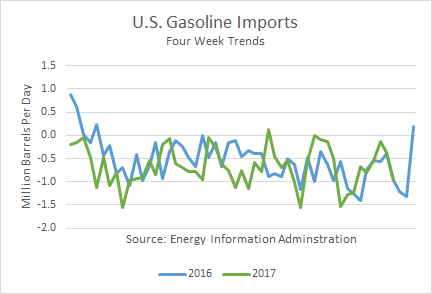
Net gasoline exports increased by 603,000 b/d to average 973,000 b/d over the past four weeks. Exports had been dropping-off but suddenly shot up.
Demand
Total petroleum demand averaged 20.299 mmbd over the past four weeks, up 2.6 % % v. last year. In the YTD, product demand averaged 20.109 mmbd, up 0.2% v. the same period in 2016.
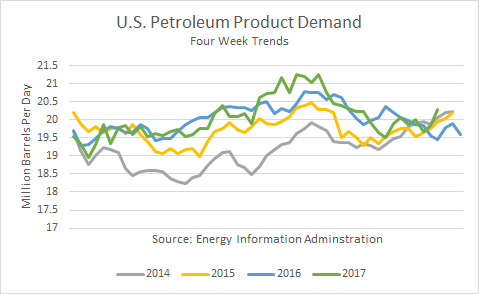
Gasoline demand at the primary stock level rose by 336,000 b/d last week and averaged 9.034 mmbd over the past four weeks, up 0.4 % v. the same weeks last year. In the YTD, it reported that gas demand is off 1.0 % v. a year ago.
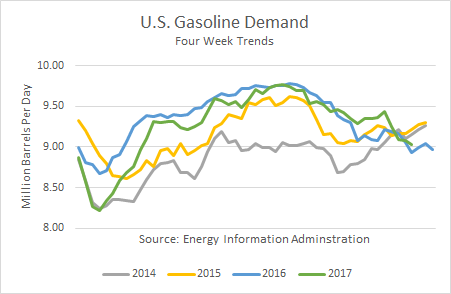
Distillate fuel demand, which includes diesel fuel and heating oil, fell by 454,000 b/d last week, averaging 3.981 mmbd over the past four weeks, off 1.2 % v. the same weeks last year. However, in the YTD, demand is up 6.3 % v. a year ago.
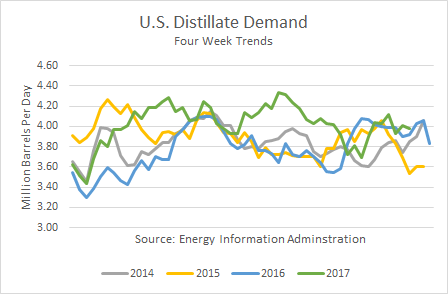
Jet fuel demand is up 10.6 % over the past four weeks v. the same weeks in 2016. In the YTD, demand was 4.3 % higher v. 2016.
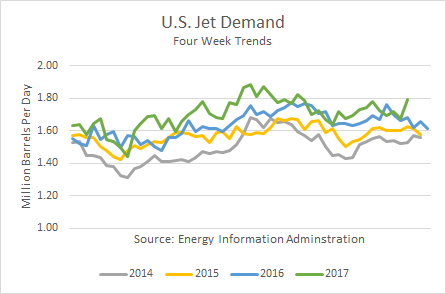
Product Stocks
Gasoline stocks are now 1.0 mmb lower than a year ago, ending at 228.7 mmb.
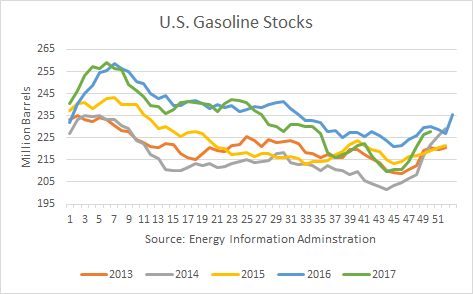
Distillate stocks are 24.7 mmb lower than a year ago, ending at 128.8 mmb.
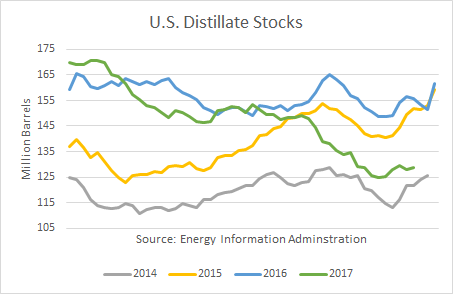
Conclusions
The production data points above add further weight to the thesis that supply gains will offset more of OPEC’s voluntary cuts in 2018, and that U.S. production growth has not slackened. They also show that U.S. crude oil and petroleum product stock draws have resulted largely from high crude and product exports. If exports drop due to lower global demand in the first quarter of 2018, U.S. inventories should build once again.
Check back to see my next post!
Best,
Robert Boslego
INO.com Contributor - Energies
Disclosure: This contributor does not own any stocks mentioned in this article. This article is the opinion of the contributor themselves. The above is a matter of opinion provided for general information purposes only and is not intended as investment advice. This contributor is not receiving compensation (other than from INO.com) for their opinion.

Around "the patch" for what 40+ yrs now and owning stripper wells 2-3 making 300+ bbl month 90,000 mcf nat gas is not a bad go. No matter what reality is this after trading the equity markets during 70'sm when dow was 900. Getting caught long silvreer contrats when unker Hunt created limit down orders daily for a week I'm still here. Really not hard to figure out, put few dollars into 2-4 3 ell lease, not moving much water, run longstroke units slow, swell little gas and over time 300+ bbls a month average income over time be $60,000- $100,000. Beats working a job! Anyone want in I'm going to taked orri, own some of the minerals. Nice little ole 240 acre lease, great disposal well, takes it on gravity. Take a piece or all. Quit worrying about #s thrown out there by others; if they can forecast correctly they wouldn't be wasting time with others. They're just creating market interest for behind the scenes business actions.
"If exports drop due to lower global demand in the first quarter of 2018, U.S. inventories should build once again."
Fat chance.
I am a small oil producer in Kansas. I haven't believed any EIA or DOE (or any other government numbers) for many years. Perhaps I'm a fool. What is the field price of oil in ND? It certainly is nowhere near $60/bbl. In KS the field price for 40 gravity is about $52. I don't know what the break even price is in ND, but some of the public companies are not telling the truth in order to keep their stock price up. Why won't our government protect the US against other countries' oil companies? They have no profit motive, so we are at a disadvantage. Throw in the environmentalist religion, and I have lots to bitch about.